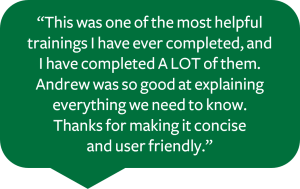As a trainer of Greenphire technology, the conversations I regularly have with site staff are often focused on the applications they will be using during their particular study: ClinCard, ConneX, eClinicalGPS, or EnvisiX. Rare is the opportunity when I’m offered a chance to gather in a room with a diverse group of staff members from various sites, sponsors, and other technology vendors, all with the shared purpose of engaging in a collaborative discussion around trainings themselves, and how we might improve upon existing practices. I was thrilled to learn that this was exactly the opportunity I was to be provided when I was invited to attend the 2022 SCRS Global Summit and speak on a panel, Advancing Technology with Attention to Site & Participant Burden. During my time on the panel, and throughout the SCRS event in its entirety, I had the chance to hear directly from sites regarding the ongoing burden of frequent technology trainings, as well as their thoughts on what creates the ideal training experience. Below are five of my top takeaways from those discussions:
1. Provide training in different formats:
Considering the fundamental fact that not every person learns the same way, implementing a multi-pronged approach to training is paramount. Some may prefer to watch an instructional video that can be viewed at a time that best suits their schedule. Others may wish to register for and attend a live session on a pre-determined date and time to participate in a more robust overview, demonstration, and opportunity to ask questions from a trainer. Still, others may be most comfortable learning by doing, and greatly appreciate tips, tricks, and on-demand reference materials built directly into the application that are made easily accessible at any given time. By providing multiple avenues for consuming educational materials and learning how to use a given platform in a way that best suits the individual, we set site staff up for success when it comes to easy adoption and overall satisfaction with the technology.
2. Adaptability for Existing Knowledge or Prior Experience:
Many of the most commonly used technologies in the industry have been leveraged across a multitude of studies at sites around the globe, it is not at all unusual for a newly onboarding coordinator to have had prior experience using a product or platform during work at a previous site, or working on a different study. Bearing in mind that there may still be a need for some training around how the technology will be used on a study-specific level, it’s worth taking steps to avoid pushing site staff through continuous duplicative trainings if they are already comfortable with the fundamentals of the product. This again echoes the notion that one size does not fit all when it comes to training, and the value of providing site staff with several options when it comes to how they would prefer to learn a technology.
3. Ongoing Access to Guidance and Support
No matter how robust or effective an initial onboarding training may be, of equal or greater importance is the need for ongoing access to guidance and support. Time may pass between when a coordinator is initially trained, and when they actively begin using the product during the study. That’s why Greenphire solutions continue to provide tips and tricks, pop-up reminders, and Knowledge Center reference guides for quick answers to questions that may arise during the study. These on-demand support features empowers sites to easily find many of the answers they need without escalating support tickets or wasting valuable time.
4. Accommodating Time Zones and Schedules
Given that many studies include sites which are located all over the globe, it’s important to provide equal training opportunity across multiple time zones in order to accommodate as wide a variety of schedules and staff availability as possible. While this challenge can sometimes be approached by providing recordings to sites, Greenphire offers a standard schedule of live trainings on several different schedules so users can get help from a Greenphire Expert at a time that works for them. This approach not only welcomes more coordinators to join live sessions and ask questions, but also provides the opportunity for a trainer to address any country or region-specific variations that might come into play when using the given technology.
5. Providing and Welcoming Feedback
The true value of feedback is often found in the constructive comments – finding out what worked well is as important as discovering what didn’t work well, and what can be done to improve a training, or the technology itself? The Greenphire Training team was born as a direct result of site feedback, and we as trainers continue to operate with the philosophy that we can always be doing more for sites by providing them with an opportunity to be heard, listening with sincerity, and adapting our current practices in any way we can in order to make improvements on our approach to education.
Ultimately, listening to what sites need and what is being asked for is the most powerful tool available when it comes to improving and continuing to adapt and update strategies to educate and empower our users.

The prevailing theme across all five of the above considerations is a site-centric perspective and approach when it comes to technology adoption and subsequent trainings. At the heart of a good training strategy is effective communication, which should always be a two-way street. Seamless usage, maximum adoption and site-centricity are our focus on the Greenphire Training team. The more we as trainers take the time to not only listen to what sites are asking for, but also take action to adapt our approaches and remain agile regarding our strategies, the greater we are able to aid in removing a portion of the burden placed on site staff when it comes to technology training.
We’re passionate about improving your clinical trial journey, check out these resources to learn more!
- New to Greenphire? Speak with an expert to learn more about our solutions.
- Already a Greenphire user? Need more training or support? Visit our Support form.



